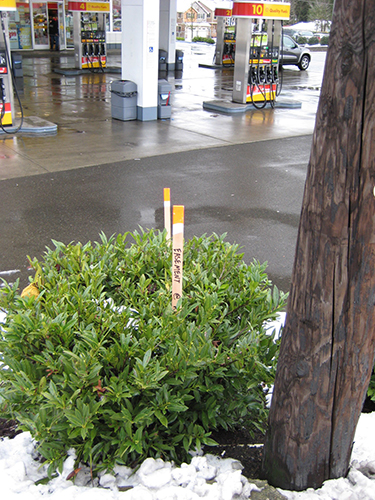|
Subscribe / Renew |
|
|
Contact Us |
|
| ► Subscribe to our Free Weekly Newsletter | |
| home | Welcome, sign in or click here to subscribe. | login |
Real Estate
| |
 |
December 12, 2013
Easements: Not just for highways and driveways
Roland Resources
There is a common misunderstanding regarding how and when to use easements to solve a real estate need. Most people assume easements are only useful for highways and driveways. The truth is an easement is a great tool in real estate transactions to grant, receive, restrict or benefit any portion of a property right that you have or need.
Fee simple ownership is the entire bundle of property rights you own. An easement is very simply one or more of the property rights in the bundle of rights that you can convey or restrict on your property.
For benefit of all of the lawyers, this is not meant to be a dissertation on all of the legal elements of an easement. Our goal here is to help you better understand when and how an easement can be effective, and in most cases the appropriate method to transfer a portion of a property interest.
An easement either benefits or burdens a property. It can be temporary or permanent. It burdens the land it comes from and benefits the land it goes with. In the case of conservation or restrictive easements, they may simply remove a portion of the property interest for the benefit of the community, or the habitat.

Roland
|
To determine if an easement is a better solution for you, think in terms of what you can do or what you can’t do on a property. The simplest way to craft an easement is to determine what the purpose for the easement is — for example roads or utilities, parking, or development right restriction. Does it allow me to do anything beyond that purpose, what geographic area of the property does it cover and what is the duration of the easement, temporary or permanent? Which property does the easement benefit and which does it burden?
One of the hidden or often overlooked benefits to acquiring or conveying an easement is that only a portion of the value of your land is affected.
If I need to buy a driveway access from my neighbor to get to my new house, the driveway easement will cost less to acquire than if I had to purchase a similar sized, fee simple strip of land. In addition, my neighbor’s property is still intact and the boundaries don’t change. In most cases his setback and density calculations for future development doesn’t change. He can still do all of the things he could before, except restrict me from driving over my new driveway.
Traditional vs. non-traditional
I did say easements are not just for highways and driveways, so let’s compare both traditional and non-traditional uses.
Typically, people think of easements only being acquired by a government or utility for public infrastructure. When a road needs to be widened or a power line needs expanding, the government or utility company will typically buy an easement “over, across, under and through a property describes as X for the purpose of building, operating and maintaining a public highway/electric power line corridor, etc.”
In other words, they can only use the easement for a highway or utility corridor purpose. They cannot come back later and say now we are going to use it for a park or a gas pipeline, unless those uses are specifically included in the purpose of the easement.
Alternatively, a government or conservation entity may purchase a restrictive easement from you. They may buy all but one of your development rights, or restrict your property to a particular use, such as preserving farmlands or habitat. In order to do this, the public agency or nonprofit organization will appraise your property at its current highest and best use. They will then appraise again showing the restricted use and pay you the difference in those two values. A restrictive easement then burdens your property, allowing only certain types of use in the future. You have been paid for the permanent restriction to your property, just the same as if a permanent driveway were placed on one corner of your lot.
In commercial settings, easements can benefit neighboring properties for underground parking, above ground air or view rights, etc. I can use the underground portion of a neighboring property and they can still have a building, a park or more parking on the surface of the adjoining land.
In many jurisdictions, including King County, development rights can be removed from one property and added to another property. The burdened property is then restricted permanently from all or a portion of future development. The benefitted property receives the right to a more dense development.
From a government perspective, most agencies only acquire sufficient property absolutely necessary to “build, operate and maintain” their capital project. You as a taxpayer don’t want them to spend any more than they have to either.
In a few cases, a project requires a capital project to purchase fee simple rights, such as restricted access highways. Examples of this are Interstate 5 or the underground highway tunnel. Those are typically fee simple purchases. More often a public entity or utility wants to limit the damage and expense created by a fee simple purchase, so they acquire easements.
From a commercial perspective, it’s all about costs. A commercial project may need only a small portion of land from an adjoining property for an access easement, nothing more. An easement limits the commercial developer’s costs and the property impacts. Everybody wins.
Contamination? Think easement
Environmentally challenging properties are another great opportunity to use easements to structure your transaction. If you don’t want to hold a possessory interest in a contaminated property, first buy an easement. You can purchase development rights on the property and secure an easement on the title. You then place funds in escrow to clean up the site, before purchasing the remaining underlying fee interest to the clean property.
Think about crafting an easement in terms of what they allow or what they restrict. If a driveway easement allows ingress and egress to a single-family residential lot, then you can’t build an apartment relying on this access. If a restrictive easement says you can only use the property for recreational public access trails, then you may not be able to build a house and use the “trail” for your driveway.
The key to successful use of easements in your transactions is first determining your purpose of the property rights you need. What are you trying to grant or restrict on a given property? Next, hire professionals that understand the difference between an easement and a fee simple purchase. There are attorneys, appraisers and negotiators that know the difference. You may need a surveyor or someone to describe a portion of a whole parcel. Work with a good title/escrow company who again understands partial conveyances of real estate.
There are not as many easements transacted as fee simple transfers. You may have to walk someone through the purpose of your transaction.
If you own a property interest, you can convey a portion of it to someone else for a given purpose, as long as it is legal of course! Easements provide creative, less expensive alternates to fee simple transactions in many ways. Consider easement solutions to your complex real estate transactions.
Faith A. Roland, SR/WA, is CEO of Roland Resources, a WBE/DBE consulting firm specializing in public infrastructure real estate transactions for public and private entities. She is past international president of the International Right of Way Association and is a certified instructor, teaching negotiating and management skills.
Other Stories:
- Empty strip mall? Here’s how to fill it
- Survey: Urban Visions
- Survey: Thomas Co.
- Survey: Barrientos LLC
- Survey: Wright Runstad and Co.
- Survey: Flinn Ferguson
- Survey: Lake Union Partners
- Survey: Schnitzer West
- State of the Market: Fledgling tech likes ‘gritty’ office buildings
- State of the Market: Is a banner year on tap for industrial properties?
- State of the Market: Retailers cash in on strong local market
- State of the Market: Multifamily rides Seattle’s strong job market
- 40-year-old plan could amp up downtown livability
- Commercial property owners deal with rising flood insurance
- Survey: Wallace Properties



